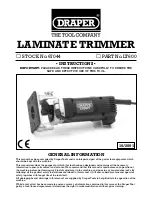
7
STOrAge reCOMMeNdATIONS
1. The best storage place is one that is cool and dry away from
direct sunlight and excess heat or cold.
2. Long storage will not harm the battery pack or charger.
CHArgINg PrOCedUre
The standard charger provided will charge a fully
depleted battery in about 2 hours. A 80% charge is
available in 1 hour.
1. Plug the charger into an appropriate outlet
before inserting the battery pack.
2. Insert the battery pack into the charger as shown
in figure 1.
3. The green LED (figure 1a) will flash
indicating that the battery is being charged.
4. The completion of charge is indicated
by the green LED (figure 1a) remaining on
continuously. The pack is fully charged and
may be used at t his time or left on the charger.
recharge discharged batteries as soon as possible after use or
battery life may be greatly diminished.
CHArger dIAgNOSTICS
This charger is designed to detect certain problems that can arise
with the battery packs or the power source. Problems are indicated
by one LED (figure 1a) flashing in different patterns.
BAd BATTery
The charger can detect a weak or damaged battery. The red
LED (figure 1a) flashes in the pattern indicated on the label.
If you see this bad battery blink pattern, do not continue
to charge the battery. Return it to a service center or a
collection site for recycling.
HOT/COLd PACk deLAy
When the charger detects a battery that is excessively hot
or excessively cold, it automatically starts a Hot/Cold Pack
Delay, suspending charging until the battery has normalized.
After this happens, the charger automatically switches to the
Pack Charging mode. This feature ensures maximum battery
life. The red LED (figure 1a) flashes in the pattern indicated on
the label when the hot / cold pack delay is detected.
LeAVINg THe BATTery IN THe CHArger
The charger and battery pack can be left connected with the green
LED (figure 1a) glowing indefinitely. The charger will keep the battery
pack fresh and fully charged.
IMPOrTANT CHArgINg NOTeS
1. Longest life and best performance can be obtained if the battery
pack is charged when the air temperature is between 60°F and
80°F (16°- 27°C). DO NOT charge the battery pack in an air
temperature below +40°F (+4.5°C), or above +105°F (+40.5°C).
This is important and will prevent serious damage to the battery pack.
2. The charger and battery pack may become warm to touch
while charging. This is a normal condition, and does not indicate a
problem. To facilitate the cooling of the battery pack after use, avoid
placing the charger or battery pack in a warm environment such as
in a metal shed, or an uninsulated trailer.
3. If the battery pack does not charge properly:
a. Check current at receptacle by plugging in a lamp or other
appliance
b. Check to see if receptacle is connected to a light switch
which turns power off when you turn out the lights.
c. Move charger and battery pack to a location where the
surrounding air temperature is approximately 60°F and 80°F
(16°- 27°C)
d. If charging problems persist, take the tool, battery pack and
charger to your local service center.
4. The battery pack should be recharged when it fails to produce
sufficient power on jobs which were easily done previously. DO
1
1a








































